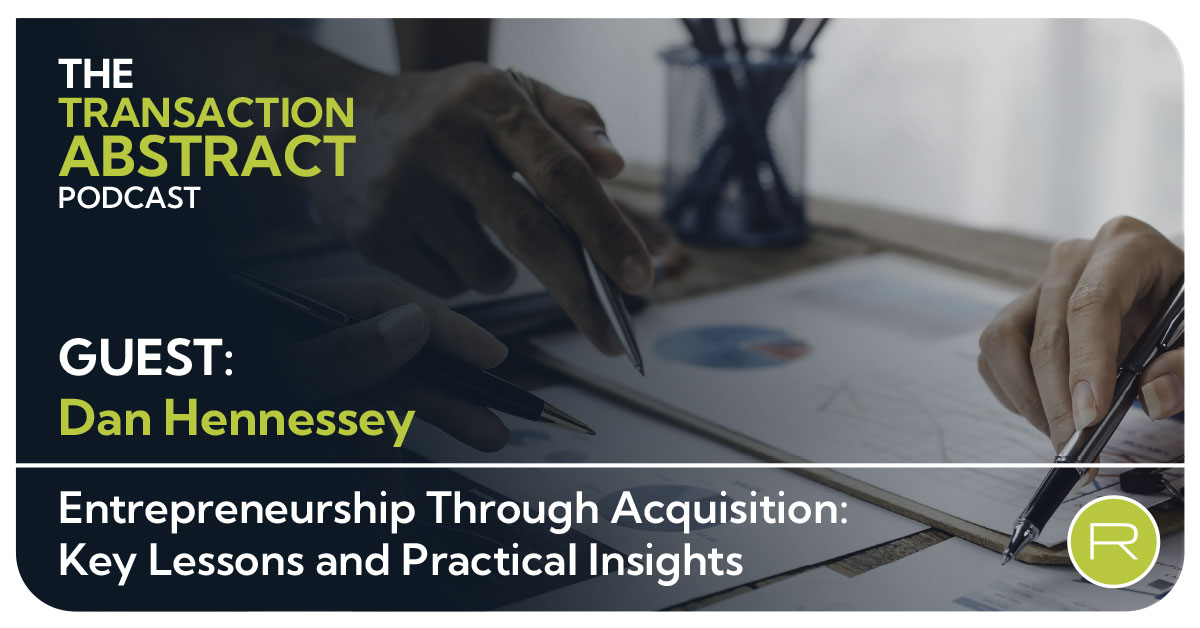Entrepreneurship Through Acquisition: Key Lessons From Dan Hennessey
In this episode of The Transaction Abstract Podcast, Joe Hellman sits down with Dan Hennessey, the newly appointed CEO of Sam Schwartz Pedestrian...
2 min read
 Joe Hellman, CPA
:
Oct 10, 2024
Joe Hellman, CPA
:
Oct 10, 2024
![Evaluating Software Companies in Mergers and Acquisitions [PODCAST]](https://www.redpathcpas.com/hubfs/Podcast/The%20Transaction%20Abstract%20Social%20Post%20and%20Blog%20Graphic%201200x678%20NEW.jpg)
Anders Olson, director at Hennepin Partners, joined The Transaction Abstract podcast host, Joe Hellman of Redpath and Company, to explore the key aspects of technology mergers and acquisitions (M&A), particularly in the software sector. As they delve into the topic, they emphasize the growing relevance of software and the specific factors that make it a highly sought-after asset in today's market. Olson explains that software has become pervasive, powering everything from our phones to toothbrushes. A quote by venture capitalist Marc Andreessen is highlighted: "Software is eating the world," illustrating software's increasing ubiquity and mission-critical nature across industries.
LISTEN TO THE PODCAST:
Olson explains that software has become pervasive, powering everything from our phones to toothbrushes. A quote by venture capitalist Marc Andreessen is highlighted: "Software is eating the world," illustrating software's increasing ubiquity and mission-critical nature across industries.
Hellman and Olson then shift the focus to software in M&A transactions, emphasizing that software businesses are often valued for their recurring revenue models rather than their profitability. Olson underscores that software is generally more resilient during economic downturns because businesses rely heavily on it for their day-to-day operations. This makes software assets particularly attractive to investors and companies looking to grow through acquisition.
Olson goes on to detail the top metrics investors focus on when evaluating a software company. Among the key performance indicators (KPIs) are:
A particularly important metric in software M&A is the Rule of 40, which combines revenue growth and profit margins (EBITDA). A company meets the Rule of 40 if its growth rate and profit margins add up to at least 40%. This metric has become a standard for evaluating the balance between growth and profitability in software businesses. Olson mentions that in recent years, buyers have shown a preference for companies that achieve a balance of at least 10% revenue growth and healthy profit margins, though higher growth rates were favored pre-COVID.
The conversation also touches on the importance of preparing for a liquidity event, whether a company is aiming for a sale or seeking external funding. Olson advises business owners to start tracking KPIs early, even if they don't plan on selling immediately. Having strong organizational processes in place and a clear growth roadmap is essential for maximizing valuation when the time comes.
In the latter part of the podcast, Olson discusses current trends in software valuations. Despite recent market fluctuations, software remains a resilient and highly valued sector. Premium software assets with strong recurring revenue streams can still command double-digit ARR multiples, although valuations have slightly moderated from the post-COVID surge. For businesses with lower growth but strong profitability, buyers might shift their focus from ARR to EBITDA multiples, underscoring the importance of a balanced financial profile.
Overall, the episode offers a deep dive into the critical metrics and strategies that drive successful software M&A transactions, providing both business owners and advisors with actionable insights on preparing for and navigating this complex landscape.

In this episode of The Transaction Abstract Podcast, Joe Hellman sits down with Dan Hennessey, the newly appointed CEO of Sam Schwartz Pedestrian...
![Common Legal Pitfalls in M&A Transactions with Kim Lowe [PODCAST]](https://www.redpathcpas.com/hubfs/Podcast-Legal-Pitfalls-Kim-Lowe.jpg)
In this episode of The Transaction Abstract Podcast, Joe Hellman sits down with Kim Lowe, Partner at Avisen Legal, to discuss the most common legal...
![Legal Considerations in Self-Funded Search Fund Transactions with Jake Parsley [PODCAST]](https://www.redpathcpas.com/hubfs/Blog%20Images/%5BTEMPLATE%5D%20RED%20Podcast-%2012-122024%20(1).png)
In this episode of The Transaction Abstract Podcast, Joe Hellman speaks with Jake Parsley, a partner at SMB Law Group specializing in search fund...